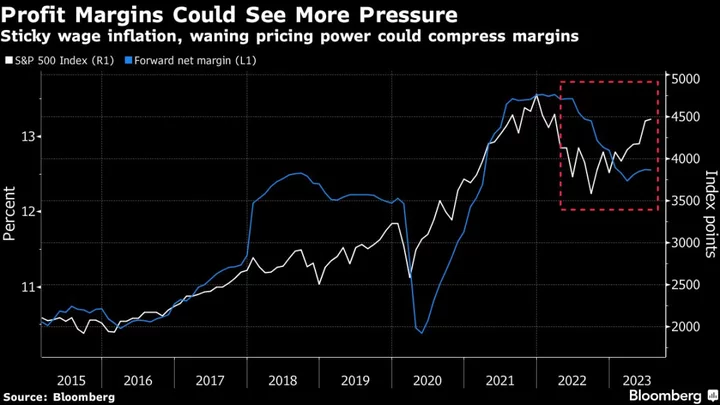A near-$10 trillion rally for global stocks this year will face a make-or-break moment as hundreds of companies report earnings over the next few weeks.
S&P 500 firms are expected to post a 9% drop in profits in the second quarter, making it the worst season since 2020, according to data compiled by Bloomberg Intelligence. In Europe, it may be even worse, with a projected 12% slump. But with the bar already low — and some indicators suggesting an earnings recovery next year — strategists are split on how the market will react.
“I’m skeptical companies will be able to demonstrate the same degree of earnings resilience this quarter,” said Evgenia Molotova, senior investment manager at Pictet Asset Management. “Top-line growth and margin stability will be key to seeing whether profits will be able to rebound in the second half.”
Areas of focus for market watchers include the impact of a slumping dollar on big exporters to the US, the substance behind the artificial intelligence buzz that powered the stock rally this year, and clues about how much firms are being affected by higher costs and a consumer squeeze.
Here are five things investors are watching:
Big Tech Influence
The frenzy around AI spurred the technology-heavy Nasdaq 100 to its best ever first-half. Now, investors will be looking for evidence of the earnings implications of the nascent technology.
“If enthusiasm for AI fails to adequately materialize in technology companies’ earnings, we could experience at least a temporary correction in share prices,” said Aneeka Gupta, director of macroeconomic research at WisdomTree.
The biggest technology stocks — Apple Inc., Microsoft Corp., Amazon.com Inc., Nvidia Corp. and Google-parent Alphabet Inc. — are expected to post the best earnings growth among US companies this quarter, according to Bloomberg Intelligence.
Inflation Effect
Signs of cooling inflation have stoked optimism that the Federal Reserve may be able to stop hiking rates soon. For companies, the news isn’t as positive because labor and other costs are still elevated, while they are struggling to raise prices for customers any further.
“Headline inflation has slowed faster than wages, which could help consumers, but hurt margins,” said Rob Haworth, senior investment strategist at US Bank Wealth Management. “We will be watching the interaction of wage growth with price inflation for whether businesses remain under pressure.”
Nokia Oyj and restaurant chain Cracker Barrel Old Country Store Inc. were among those warning about the impact of higher costs in early earnings reports.
Consumer Squeeze
Market participants said they’re focused on the tone around consumer spending and looking at auto sales and the travel and hospitality sector to assess the health of Corporate America. Another area of focus will be company debt loads and refinancing plans, especially for those with weaker balance sheets.
“Consumers have propped up the US economy for months, spurred by a strong labor market and excess savings, so any evidence of belt tightening, trading down or fading spend on services will be key,” said Ross Mayfield, investment strategy analyst at Baird.
Adjusted for inflation, US consumer spending has largely stalled after surging at the start of the year, and some early signs from companies haven’t been good. Memory-chip maker Micron Technology Inc. said it expects a contraction in PC and smartphone markets and German chemicals giant BASF SE warned on profits, blaming slow demand for consumer products.
That means forecasts for a swift earnings rebound next year may be too optimistic and leave stocks vulnerable to a selloff if companies sound cautious, according to Morgan Stanley strategist Michael Wilson — one of the most bearish voices on Wall Street.
Europe’s Waning Outperformance
European profits are expected to drop more than those in the US, because of weakness in the manufacturing sector, according to Barclays Plc strategists. Big exporters are also facing a further hurdle as currencies including the euro and Swiss franc strengthen. Watchmaker Swatch Group AG — which has high fixed costs in Switzerland — warned that currency shifts will weigh on sales this year.
The equity market began to reflect Europe’s challenges in the April-June period, when the Stoxx 600 underperformed the S&P 500 in dollar terms. While cheaper valuations have made regional stocks attractive again for some, others say a dearth of technology stocks could keep the outlook choppy.
Choppy China Rebound
China’s stock market has missed out on the global rally this year amid a weak economic rebound, deepening concerns about the property sector and surging youth unemployment.
Reports from the country’s automakers are expected to be a bright spot as domestic sales and exports gain momentum, while technology firms’ results may be weak as global chip markets remain lackluster.
The stakes are also high for international firms with exposure to China, like Europe’s luxury giants. Burberry Group Plc said on Friday that demand in China helped to compensate for weakness in the US. Investor favorites LVMH and Kering SA — which started to show some cracks earlier this year — will also be scrutinized for their performance in Asia.
Fabiana Fedeli, chief investment officer for equities and multi assets at M&G Plc, said beauty and sporting goods firms that sell in China face more risks than luxury companies because of their customer demographic.
--With assistance from Namitha Jagadeesh and April Ma.

